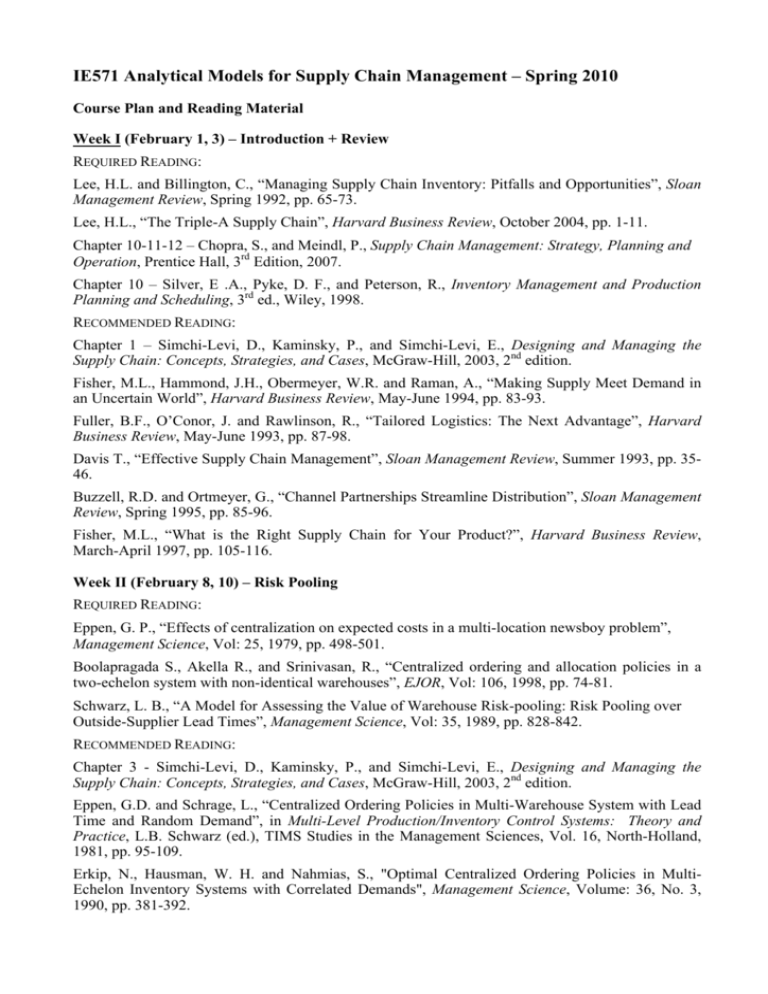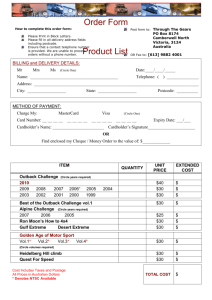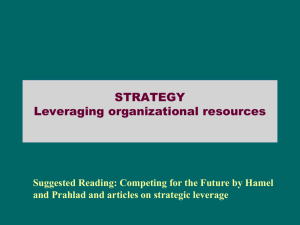New version of Course Outline is added
advertisement

IE571 Analytical Models for Supply Chain Management – Spring 2010 Course Plan and Reading Material Week I (February 1, 3) – Introduction + Review REQUIRED READING: Lee, H.L. and Billington, C., “Managing Supply Chain Inventory: Pitfalls and Opportunities”, Sloan Management Review, Spring 1992, pp. 65-73. Lee, H.L., “The Triple-A Supply Chain”, Harvard Business Review, October 2004, pp. 1-11. Chapter 10-11-12 – Chopra, S., and Meindl, P., Supply Chain Management: Strategy, Planning and Operation, Prentice Hall, 3rd Edition, 2007. Chapter 10 – Silver, E .A., Pyke, D. F., and Peterson, R., Inventory Management and Production Planning and Scheduling, 3rd ed., Wiley, 1998. RECOMMENDED READING: Chapter 1 – Simchi-Levi, D., Kaminsky, P., and Simchi-Levi, E., Designing and Managing the Supply Chain: Concepts, Strategies, and Cases, McGraw-Hill, 2003, 2nd edition. Fisher, M.L., Hammond, J.H., Obermeyer, W.R. and Raman, A., “Making Supply Meet Demand in an Uncertain World”, Harvard Business Review, May-June 1994, pp. 83-93. Fuller, B.F., O’Conor, J. and Rawlinson, R., “Tailored Logistics: The Next Advantage”, Harvard Business Review, May-June 1993, pp. 87-98. Davis T., “Effective Supply Chain Management”, Sloan Management Review, Summer 1993, pp. 3546. Buzzell, R.D. and Ortmeyer, G., “Channel Partnerships Streamline Distribution”, Sloan Management Review, Spring 1995, pp. 85-96. Fisher, M.L., “What is the Right Supply Chain for Your Product?”, Harvard Business Review, March-April 1997, pp. 105-116. Week II (February 8, 10) – Risk Pooling REQUIRED READING: Eppen, G. P., “Effects of centralization on expected costs in a multi-location newsboy problem”, Management Science, Vol: 25, 1979, pp. 498-501. Boolapragada S., Akella R., and Srinivasan, R., “Centralized ordering and allocation policies in a two-echelon system with non-identical warehouses”, EJOR, Vol: 106, 1998, pp. 74-81. Schwarz, L. B., “A Model for Assessing the Value of Warehouse Risk-pooling: Risk Pooling over Outside-Supplier Lead Times”, Management Science, Vol: 35, 1989, pp. 828-842. RECOMMENDED READING: Chapter 3 - Simchi-Levi, D., Kaminsky, P., and Simchi-Levi, E., Designing and Managing the Supply Chain: Concepts, Strategies, and Cases, McGraw-Hill, 2003, 2nd edition. Eppen, G.D. and Schrage, L., “Centralized Ordering Policies in Multi-Warehouse System with Lead Time and Random Demand”, in Multi-Level Production/Inventory Control Systems: Theory and Practice, L.B. Schwarz (ed.), TIMS Studies in the Management Sciences, Vol. 16, North-Holland, 1981, pp. 95-109. Erkip, N., Hausman, W. H. and Nahmias, S., "Optimal Centralized Ordering Policies in MultiEchelon Inventory Systems with Correlated Demands", Management Science, Volume: 36, No. 3, 1990, pp. 381-392. Hausman, W.H. and Erkip, N., “Multi-Echelon vs. Single-Echelon Inventory Control Policies for Low Demand Rates”, Management Science, Vol: 40, No: 5, 1994, pp. 597-602. Week III (February 15, 17) – Risk Pooling – Continued. Week IV (February 22, 24) – Design REQUIRED READING: Daskin, M.S., Snyder, L.W., and Berger, R.T., “Facility Location in Supply Chain Design”, in Logistics Systems: Design and Optimization, Edited by: A. Langevin and D. Riopel, Springer US, 2005. Nozick, L.K. and Turnquist, M.A., “Inventory, Transportation, Service Quality and the Location of Distribution Centers”, EJOR, Vol: 129, 2001, pp. 362-371. Eskigun, E., Uzsoy, R., Preckel, P.V., Beaujon, G., Krishnan, S., and Tew, J.D., “Outbound Supply Chain Network Design with Mode Selection, Lead Times and Capacitated Distribution Centers”, EJOR, Vol: 165, 2005, pp. 182-206. RECOMMENDED READING: Harrison, T.P., “Global Supply Chain Design”, Information Systems Frontier, Vol: 3, No: 4, 2001, pp. 413-416. Meixell, M.J. and Gargeya, V.B., “Global Supply Chain Design: A literature Review and Critique”, Transportation Research Part E, Vol: 41, 2005, pp. 531-550. Chapter 2 - Simchi-Levi, D., Kaminsky, P., and Simchi-Levi, E., Designing and Managing the Supply Chain: Concepts, Strategies, and Cases, McGraw-Hill, 2003, 2nd edition. Week V (March 1, 3) – Design (Continued) + Review of some fundamental studies REQUIRED READING: Clark, A. J. and Scarf, H. “Optimal Policies for the Multi-Echelon Inventory Problem”, Management Science, Vol: 6, 1960, pp. 475-490. Sherbrooke, C. G., “METRIC: a multi-echelon technique for recoverable item control”, Operations Research, Vol: 16, 1968, pp. 122-141. RECOMMENDED READING: Shang, K., and J. S. Song, “Newsvendor bounds and heuristic for optimal policies in serial supply chains” Management Science, Vol: 49, 2003. pp. 618-638. Graves, S. C., and DeBodt, M., “Continuous-Review Policies for a Multi-Echelon Inventory Problem with Stochastic Demand”, Management Science, Vol. 31, 1985, pp.1286-1299. Graves, S. C., “A Multi-Echelon Inventory Model for a Repairable Item with One-for-One Replenishment”, Management Science, 1985, Vol. 31, pp.1247-1256. Week VI (March 8, 10) - Review of some fundamental studies (Continued) Week VII (March 15, 17) - Value of Information and Bullwhip Effect REQUIRED READING: Lee, Padmanabhan, Whang, “The Bullwhip Effect in Supply Chains”, Sloan Management Review, Spring 1997, pp. 93-102. Lee, H.L. Padmanabhan, V. and Whang, S., “Information Distortion in a Supply Chain: The Bullwhip Effect”, Management Science, Vol: 43, No: 4, 1997, pp. 546-558. RECOMMENDED READING: Chapter 4 - Simchi-Levi, D., Kaminsky, P., and Simchi-Levi, E., Designing and Managing the Supply Chain: Concepts, Strategies, and Cases, McGraw-Hill, 2003, 2nd edition. Chen et al., “Quantifying the Bullwhip Effect in a Simple Supply Chain”, Management Science, Vol: 46, No: 3, 2000, pp. 436-443. Chen et al., “The Impact of Exponential Smoothing Forecasts on the Bullwhip Effect”, Naval Research Logistics, Vol: 47, No: 4, 2000, pp. 269-286. Week VIII (March 22, 24) Value of Information and Bullwhip Effect (Continued) + Midterm Exam Week IX (March 29, 31) Distribution Planning, Supply Chain Integration REQUIRED READING: Chapter 10 - Chopra, S., and Meindl, P., Supply Chain Management: Strategy, Planning and Operation, Prentice Hall, 2001. Karabakal, Gunal, Ritchie, “Supply Chain Analysis at Volkswagen of America”, Interfaces, 2000, pp. 46-55. Savasaneril, S. and Erkip, N.K., “An Analysis of Manufacturer Benefits under Vendor Managed Systems”, Accepted for Publication, IIE Transactions, 2010. RECOMMENDED READING: Chapter 5 - Simchi-Levi, D., Kaminsky, P., and Simchi-Levi, E., Designing and Managing the Supply Chain: Concepts, Strategies, and Cases, McGraw-Hill, 2003, 2nd edition. Rangan, V.K. and Jaikumar, R., “Integrating Distribution Strategy and Tactics: A Model and an Application”, Management Science, Vol: 37, No: 11, 1991, pp. 1377-1389. Fry, M.J., Kapuscinski, R. and Olsen, T.L., “Coordinating Production and Delivery Under a (z, Z)Type Vendor Managed Inventory Contract, MSOM, Vol: 3, 2001, pp. 151-173. Week X (April 5, 7) Semester Recess Week XI (April 12, 14) – Distribution (continued) Week XII (April 19, 21) – Distribution (continued) Week XIII (April 26, 28) – Issues of Cooperation REQUIRED READING: Pasternack, B. A., “Optimal pricing and return policies for perishable commodities”, Marketing Science, 4, 166-176 (1985) Gerchak,Y. and Wang, Y., “Revenue-Sharing vs. Wholesale-Price Contracts in Assembly Systems with Random Demand”, Production and Operations Management, Vol: 13, No: 1, 2004, pp. 23-33. Eppen, G.D. and Iyer, A.V., “Backup Agreements in Fashion Buying - The Value of Upstream Flexibility”, Management Science, Vol: 43, No: 11, 1997, pp. 1469-1484. Week XIV (May 3, 5) – – Issues of Cooperation (continued) Weeks XV (May 10, 12) – Presentations








